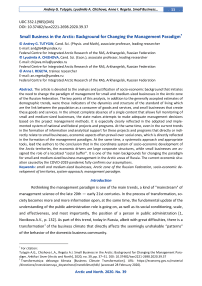Small business in the Arctic: background for changing the management paradigm
Автор: Tutygin Andrey G., Chizhova Lyudmila A., Regeta Anna I.
Журнал: Arctic and North @arctic-and-north
Рубрика: Social and economic development
Статья в выпуске: 39, 2020 года.
Бесплатный доступ
The article is devoted to the analysis and justification of socio-economic background that initiates the need to change the paradigm of management for small and medium-sized businesses in the Arctic zone of the Russian Federation. The key points of this analysis, in addition to the generally accepted estimates of demographic trends, were those indicators of the dynamics and structure of the standard of living which are the link between the population as a consumer of goods and services, and small businesses that create these goods and services. In the almost complete absence of a single content that allows full monitoring of small and medium-sized businesses, the state makes attempts to make adequate management decisions based on the project management methods. It is especially clearly reflected in the adopted and implemented system of national and federal projects and programs. At the same time, even in the current trends in the formation of information and analytical support for these projects and programs that directly or indirectly relate to small businesses, economic aspects often prevail over social ones, which is directly reflected in the formation of the management paradigm. At the same time, a systematic approach and appropriate tools, lead the authors to the conclusion that in the coordinate system of socio-economic development of the Arctic territories, the economic drivers are large corporate structures, while small businesses are assigned the role of a localized “social buffer”. It is one of the main backgrounds for changing the paradigm for small and medium-sized business management in the Arctic areas of Russia. The current economic situation caused by the COVID-2019 pandemic fully confirms our assumptions.
Small and medium-sized businesses, arctic zone of the russian federation, socio-economic development of territories, system approach, management paradigm
Короткий адрес: https://sciup.org/148318392
IDR: 148318392 | УДК: 332.1(985)(045) | DOI: 10.37482/issn2221-2698.2020.39.37
Текст научной статьи Small business in the Arctic: background for changing the management paradigm
Rethinking the management paradigm is one of the main trends, a kind of "mainstream" of management science of the late 20th — early 21st centuries. In the process of transformation, society becomes more and more information open, at the same time, the fundamental update of the understanding of the public administration role is going on, as well as its social conditioning, scale, and effectiveness, and most importantly, the position of a person in public administration [1, Novikova A.V., p. 132]. As part of this trend, today in Russia, albeit with great difficulties, there is a transformation1 of the business climate that directly affects the seemingly unshakable “patterns” of the behavior of the domestic business community.
∗ For citation:
In today's Russian reality, when it comes to small and medium-sized enterprises (SMEs), we primarily turn our eyes to the federal law with a consonant name2, which defines the criteria for referring to this category of business entities. The adjective “housekeeping” is the key there. It reflects the essence of the state’s attitude to SMEs as economic agents. Based on this, we see a reason to argue that the grounds of the state’s managerial paradigm concerning the small business is its economic essence without considering the social role.
Small business: a systematic approach
The totality of small and medium-sized businesses for all the attributes it has with full right can be attributed to socio-economic systems, defined, e.g., following [2, Drohobytsky I.N.]. In this case, the ratio of economic and social components in it should be decisive when choosing a paradigm for controlling system-forming processes. From the role settings point of view, this can be described using the following matrix (Fig. 1). Let us briefly describe its segments.
If both the social and economic components are represented to a rather high degree, then business plays the role of a development driver in the territory of its presence. Such examples exist in Russia, but they are more likely to be the exception than the rule. As examples, one can cite the business practices of such Russian regions as the Permskiy Kray, Kaluzhskaya, Lipetskaya and Moskovskaya Oblasts, the Republic of Tatarstan, which occupy leading positions in various rat-ings3.
However, much more often in those regions that can even be classified as economically prosperous, big business is aimed at the full-scale exploitation of resources to obtain the maximum economic result for itself, leaving behind “secondary” social problems for it. Indeed, local labor resources, and hence the population itself, are often simply not of interest to corporate structures, which are increasingly using the “shift method” of attracting personnel.
At the same time, in recent years, quite reasoned opinions [3, Imaeva G.R., p. 150; 4, Kuyantsev I.A. et al., p. 40; 5, Murai V.Yu., p. 81; 6, Tutygin A.G. et al.] on the growing social role of entrepreneurship as a public institution. Even the state took care of this issue in its strategic and program documents4. However, it should be understood that in this perspective, the government, in reality, not expecting any significant economic return from small and medium-sized businesses, assigns it rather the role of a “social buffer” that removes a certain tension in society. Recent speeches by President of Russia V.V. Putin5, decrees and orders of the Government of the Russian Federation6, and regional authorities7, dedicated to supporting small business in the context of the spread of COVID-2019, are proof of this.
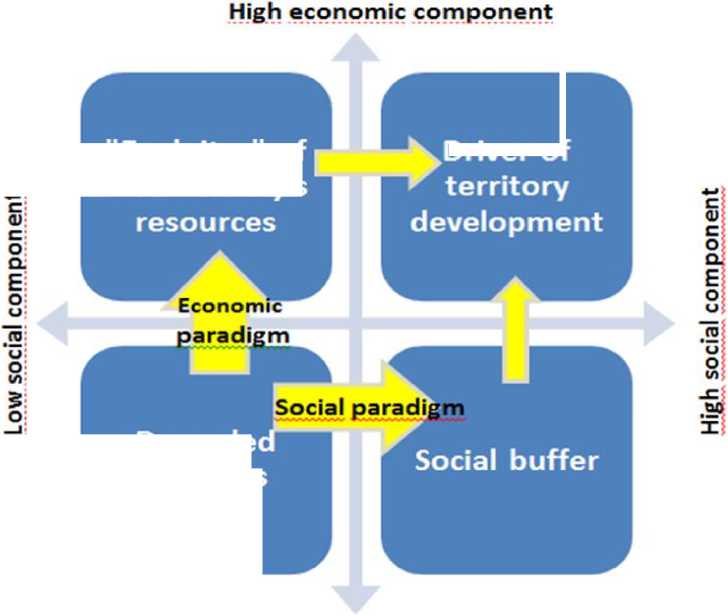
Driver of
Exploiter of the territory's
Degrade business
Low economic component
Fig. 1. Small Business Role Matrix.
Given the
apparent presence of state interests in the field of SMEs, the corresponding managerial paradigm is also being formed, which becomes the basis of state policy aimed at the
URL:
plana v Ar-
Territorial conditions and living standards in the Arctic regions
Small business, unlike large corporate structures, has a significant dependence on territorial affinity. Indeed, for almost any SME entity, the scope of its activity rarely goes beyond the boundaries of one region or even a municipality. This fact primarily applies to entrepreneurs engaged in the production of goods, agriculture, the implementation of various works, the provision of those types of services to the population that requires direct personal interaction with the consumer. Thus, often belonging to a particular territory forms the primary set of factors that significantly affect the business. It is especially evident in those territories whose conditions are unfavorable for the development of entrepreneurship. Such territories include, first, Arctic municipalities.
According to the Decree of the President of the Russian Federation of May 02, 2014 No. 296, the land territories of the Arctic zone of the Russian Federation (AZRF) as a new macro-region are fully or partially the territories of nine constituent entities of the Russian Federation, as well as land and islands in the Arctic Ocean 10. At the same time, several Arctic regions periodically come forward with initiatives to expand the borders of the Russian Arctic by incl. individual municipal entities in it. So, following the Decree of the President of the Russian Federation of June 27, 2017 No. 287, the Belomorsky, Loukhsky and Kemsky municipal regions of the Republic of Karelia have already been included in the territory of the Russian Arctic. The initiative to include the Leshukon-sky and Pinezhsky districts of the Arkhangelsk Oblast is currently under discussion.
Despite the system-wide problems typical for the Russian Arctic and the North, all the Russian Arctic territories have several individual characteristics. Firstly, the regions of the Russian Arctic differ from each other in natural resource and territorial conditions. Secondly, they have a different level of socio-economic development. Thirdly, these regions are distinguished by a set of strategic and program documents that determine their development [7, Tutygin A.G., Chizhova L.A., p. 194].
Let us consider some indicators that clearly illustrate the socio-economic situation in the Arctic regions of Russia.
Between 2005 and 2018, the population of the Russian Federation increased by 2.31%. At the same time, in the Arctic regions, it changed in different directions. In only two of them, in the Nenets and Yamal-Nenets Autonomous Okrugs, growth rates were higher than the national ones, in the Republic of Sakha (Yakutia), the increase was 1.25%. In other regions, as compared to 2005, population decline is observed, and the Republic of Komi, Murmansk, and Arkhangelsk Oblasts are
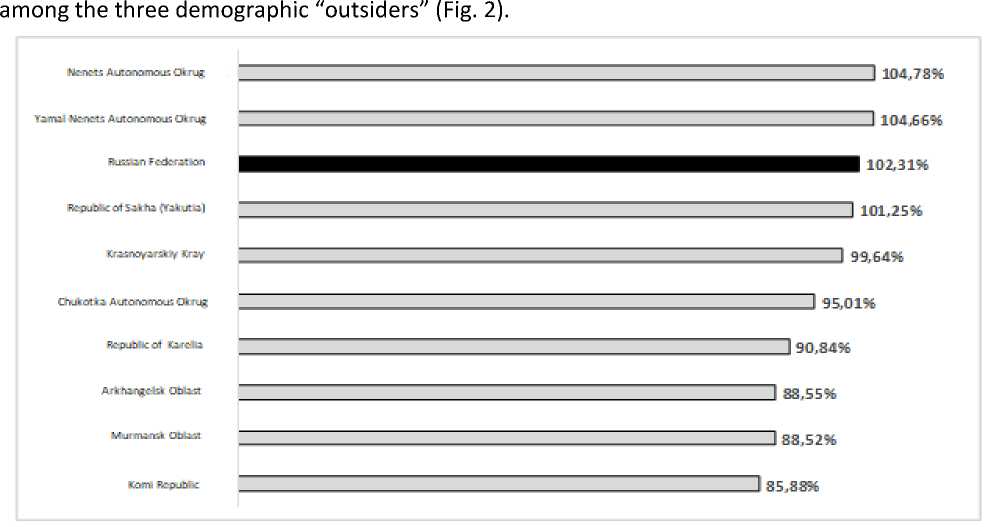
Fig. 2. The population growth rate in the regions of the Russian Arctic ( in 2018, compared to 2005), %.
In general, the population decline in the group of regions that are fully or partially part of the Russian Arctic, in 2018 amounted to – 4.64% compared to 2005.
Among the main demographic problems of the Arctic territories of Russia, in addition to reducing the population, researchers also highlight aging of the population (reduction in the working-age population); birth rate reduction; lower life expectancy in comparison with the all-Russian level; a high level of infant mortality (mainly among indigenous peoples); high incidence rate; mi- gration outflow of the able-bodied population with a high level of professional qualification [8, Gubina O.V., Provorova A.A., p. 386] and others.
The standard of living of the population is mostly determined by the ratio of its income and expenses, incl. the cost of goods and services of prime necessity. In two regions of the Russian Arctic, in the Republic of Karelia and the Arkhangelsk Oblast, the share of expenditures in the average per capita income of the population exceeds the average Russian level (75.76%), which is in Fig. 3. At the same time, a sharp difference in this indicator is observed in three subjects — the Chukotka, Nenets, and Yamal-Nenets Autonomous Okrugs, where it is about 36–42%. We note that in our analysis of the standard of living we do not consciously use the average per capita income indicator in isolation from population expenditures due to the presence of significant interregional price
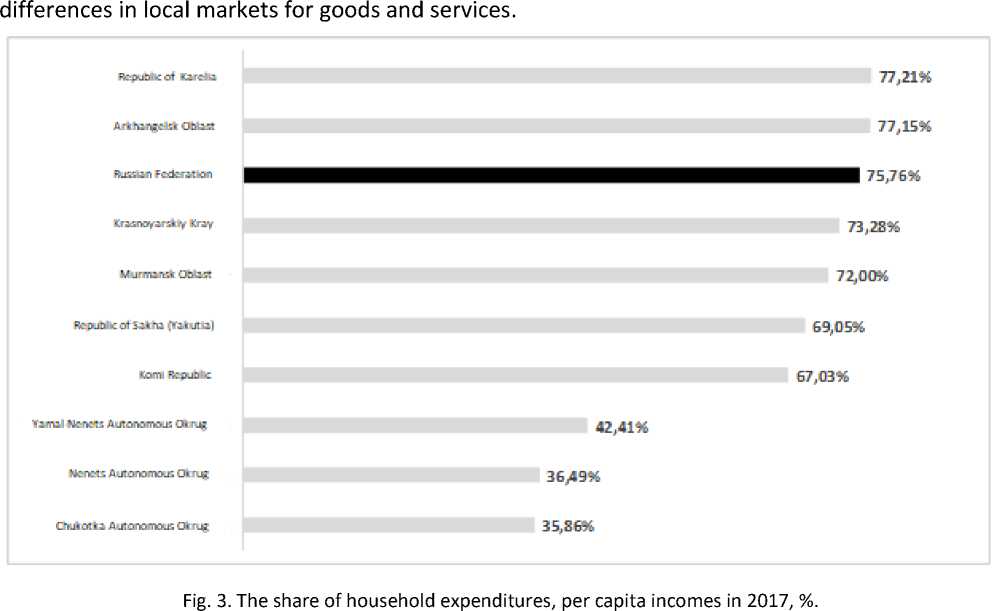
According to experts of the Institute of Economics of the Ural Branch of the Russian Academy of Sciences, this phenomenon is explained by the fact that the population of the Arctic zone of the Russian Federation does not use 40% of income in their territories, preferring to spend earned money in other regions of the country. It is due to several reasons: from the “shift method of work” to the underdeveloped local markets for goods and services in the Arctic territories. Moreover, for the municipal entities of the Russian Arctic, there is a relationship between the development of infrastructure and cash outflows [9, Zakharchuk E.A., Pasynkov A.F., Nekrasov A.A.].
An essential factor for analyzing the living standards of the population is not only the ratio of income and expenses but also the structure of the costs themselves, that is, what part of the population spends on food, the purchase of non-food products (clothing, household appliances, furniture, vehicles, etc.) and payment for services. Relevant for the northern territories is also an indicator of the share of expenses associated with the use of alcoholic beverages.
Data in the Table1 allows ranking the Russian Arctic area by the structure of expenditures of the population by groups of goods and services.
The structure of the expenditure of the AZRF population in 2017, %
Table 1
|
Subject of the Russian Federation |
Food |
Nonfood products |
Alcohol |
Payment for services |
|
Russian Federation |
34.3 |
37.1 |
1.6 |
27.0 |
|
Republic of Karelia |
37.9 |
35.1 |
2.2 |
24.8 |
|
Komi Republic |
35.5 |
32.7 |
2.2 |
29.6 |
|
Nenets Autonomous Okrug |
34.0 |
27.7 |
2.7 |
35.6 |
|
Arhangelsk Oblast |
30.8 |
43.1 |
1.2 |
24.9 |
|
Murmansk Oblast |
29.3 |
37.9 |
2.3 |
30.5 |
|
Yamal-Nenets Autonomous Okrug |
32.2 |
30.7 |
2.9 |
34.2 |
|
Krasnoyarsk Kray |
30.9 |
37.7 |
1.9 |
29.5 |
|
The Republic of Sakha (Yakutia) |
35.2 |
32.0 |
1.3 |
31.5 |
|
Chukotka Autonomous Okrug |
40.0 |
28.4 |
2.1 |
29.5 |
This ranking is especially evident in comparison with the average Russian indicators (Fig. 4).
|
Food expenses |
Non-food expenses |
||||
|
-5,0 |
Chukotka Autonomous Okrug 1 1 5,7 Republic Karelia I l 1 3,6 Komi Republic 1,2 Saha Republic 0,9
Мурманская обл. Murmansk region |
- -9,4 |
,7 |
Arhangelsk region 11 6,0 Murmansk region □ 0,8 Krasnoyarsk region □ 0,6
-6,4 ЯНАО Yamalo Nenets Autonomous Чукотский АО Chukotka Autonomous Okrug НАО Nenets Autonomous Okrug |
|
|
Alcohol |
Services |
||||
|
Yamalo Nenets Autonomous Okrug utonomous 1,3 |
Nenets Autonomous Okrug 1 ________ Yamalo Nenets |
__________________________1 8,6 |
|||
|
Nenets Autonomous Okrug \1 1,1 |
Autonomous Okrug |
________________1 7,2 |
|||
|
Murmansk region __________________________1 0,7 Republic Karelia 1 0,6 Komi Republic ' 1 0,6 Chukotka Autonomous Okrug 1 0,5 Krasnoyarsk region 1 0,3
|
Saha Republic 1 4,5 Murmansk region 3,5 Komi Republic ^^^ 2,6 Chukotka Autonomous Okrug 2,5 Krasnoyarsk region 2,5
|
||||
Fig. 4. Ranking of regions of the Russian Arctic by indicators of deviations in the structure of the expenditure of the population from the average Russian level by groups of goods and services (percentage points).
Compared with the average Russian level among the regions of the Russian Arctic, the share of food purchase costs in the structure of population costs is highest in the Chukotka Autonomous Okrug (+5.7 p.p.) and the Republic of Karelia (+3.6 p.p.). Below the national average, this indicator is in the Murmansk Oblast (-5.0 p.p.), the Arkhangelsk Oblast (-3.5 p.p.), and the Krasno-yarsky Kray (-3.4 p.p.). In terms of the share of expenses for the purchase of non-food goods, the Arkhangelsk Oblast (+6 p.p.), the Nenets, Chukotsky and Yamal-Nenets Autonomous Okrugs (-9.4 p.p., -8.7% p.p. and -6.4 p.p., respectively) significantly deviate from the average for Russia and), as well as the Republic of Sakha (Yakutia) and Komi (-5.1 p.p. and -4.4 p.p.).
If you look at the share of the population’s expenses related to payment for services, then in almost all Arctic regions, it is higher than the average Russian level — from +8.6 p.p. in the Nenets Autonomous Okrug up to +2.5 p.p. in the Krasnoyarsky Kray. The only exceptions are Arkhangelsk Oblast and Karelia, where this indicator is 2 pp below the average Russian. So, except for the Arkhangelsk Oblast and Yakutia, the average Russian bar in the structure of expenditures of the population is higher than the costs of acquiring alcoholic beverages. It is especially noticeable in the Yamal-Nenets and Nenets Autonomous Okrugs.
If we consider the dynamics of the cost structure of the population of the Arctic regions, then over the past few years it, is quite predictable, basically changed insignificantly, as evidenced by the values of the structural differences index V.M. Ryabtsev (table. 2).On a scale for assessing the significance of structural differences, most of the values of the index V.M. Ryabtsev fell into the ranges 0.000–0.030 (the identity of structures), 0.031–0.070 (very low level of difference in structures) or 0.071–0.150 (low level of difference in structures) [10, Ryabtsev V.M., Chudilin G.I.].
Table 2
The values of the V.M. Ryabtsev's index for population spending structure (2014 – 2017)
|
Subject of the Russian Federation |
Food |
Non-food products |
Alcohol |
Payment for services |
|
Russian Federation |
0.036 |
0.039 |
0.030 |
0.013 |
|
Republic of Karelia |
0.065 |
0.046 |
0.048 |
0.026 |
|
Komi Republic |
0.061 |
0.074 |
0.073 |
0.012 |
|
Nenets Autonomous Okrug |
0.054 |
0.163 |
0.286 |
0.094 |
|
Arhangelsk Oblast |
0.017 |
0.024 |
0.200 |
0.033 |
|
Murmansk Oblast |
0.017 |
0.005 |
0.021 |
0.021 |
|
Yamal-Nenets Autonomous Okrug |
0.120 |
0.163 |
0.160 |
0.069 |
|
Krasnoyarsk Kray |
0.049 |
0.043 |
0.050 |
0.012 |
|
The Republic of Sakha (Yakutia) |
0.030 |
0.032 |
0.000 |
0.073 |
|
Chukotka Autonomous Okrug |
0.061 |
0.016 |
0.235 |
0.071 |
However, it should be noted that the index values for the Nenets and Yamal-Nenets Autonomous Okrugs are distinguished from the general picture — for the positions “Non-Food Products” and “Alcohol”, structural changes fall in the range of 0.151–0.300, that is, they have a significant level. The Arkhangelsk Oblast falls into the same interval for the position “Alcohol”. Indeed, in the structure of population expenditures, the share attributable to the purchase of non-food items in just three years in the Nenets Autonomous Okrug decreased from 38.5% to 27.7%, and in the
Yamal-Nenets Autonomous Okrug — from 42.7% to 30.7%. The share of expenses on the purchase of alcohol in the population of the Nenets Autonomous Okrug increased from 1.5% to 2.7% in the
Yamal-Nenets Autonomous Okrug — from 2.1% to 2.9%. At the same time, the share of alcohol in the structure of expenditures of the population of the Arkhangelsk Oblast for the same period decreased from 1.8% to 1.2%.
The above once again confirms the conclusions that the social problems of the Arctic zone of the Russian Federation are reduced mainly to a high degree of differentiation of wages, inequality in the redistribution of monetary incomes of the population (the problem of poverty of the population), as well as social tension in regional labor markets and rhetorical differentiation of unemployment [11, Korchak E.A., p. 609; 12, Zlenko E.G., p. 69].
The role and place of small business in the Arctic
Against the background of the picture described above, which gives some idea of the living standards of the population in the northern territories, let us now try to determine the role and place of small and medium-sized businesses. The society and the state have certain hopes on it. However, they do not always have a realistic basis. To confirm what has been said, let us turn only to some facts. At the same time, we immediately make a reservation that the actual absence of municipal statistics bodies in Russia today makes it practically impossible to conduct comprehensive monitoring of the socio-economic situation in such a macro-region as the Russian Arctic in the same methodological vein by existing means. The problems arising in connection with this were already discussed in detail by the authors in our work [13, Pavlenko V.I., Melamed I.I., Kutsenko S.Yu., Tutygin A.G., Avdeev M.A., Chizhova L.I.].
An analysis of the sphere of small and medium-sized businesses in the regions of the Russian Arctic shows that over the past three years, the number of SMEs in them has generally decreased by 3.55%. The Republic of Komi (-11.19%), the Murmansk (-7.93%), and Arkhangelsk (6.77%) Oblasts, as well as the Yamal-Nenets Autonomous Okrug (-4.64%), turned out to be below the average level (Fig. 5). Moreover, in two of the three regions of the Russian Arctic, in which the growth rate of the number of SMEs exceeded 100%, namely, in the Nenets and Chukotka Autonomous Okrugs, their number does not exceed 1.5 thousand units in each. And starting in March 2020, the number of SMEs in many regions began to decline sharply due to the coronavirus pandemic. According to some operational estimates, in the number of areas of activity, such as tourism, catering, household and transportation services, revenue from the sale of goods, works and services decreased by 80–90% compared to the “pre-epidemic” level. It was especially true for those regions in which the solvent demand of the population was relatively low until this time.
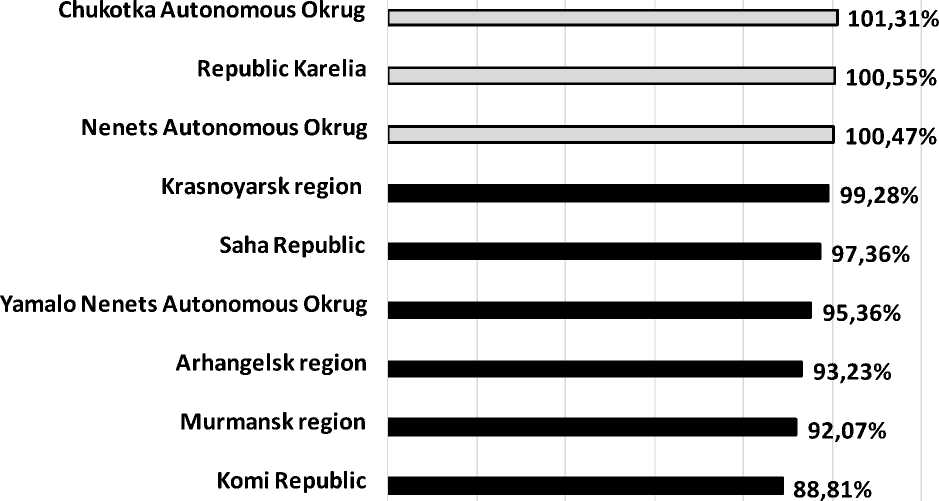
Fig. 5. The growth rate of the number of SMEs in the Arctic regions in 2017–2019,% (according to the Federal Tax Service of Russia 11).
According to several authors [14, Skufina T.P., Bazhutova E.A., Samarina V.P., pp. 63–64], in most regions of the Russian Arctic, entrepreneurial activity (EA) of the state predominates, and EA business prevails only in the Murmansk Oblast and Yamal-Nenets Autonomous Okrug, and the population EA in Krasnoyarsky Kray. As an explanation for this, an argument is given about the participation of the state in large business structures, which, as a rule, carry out activities in the main sectors of the economy of these regions. The prevailing influence of the EA of business and the state corresponds to the modern development of the Russian Arctic, which consists in a high degree of the corporatization of the Arctic economy and the active participation of the state, which has deep historical roots in the formation and development of the economy of the northern territories.
A certain paradox of the socio-economic development of the Russian Arctic is that, despite the significant contribution of this macro-region to the Russian economy, primarily due to extractive industries, and a high share of attracted investments, the social situation in its territories remains tense (population decline, high poverty, and unemployment rates, etc.) [15, Gladysheva Yu.V.].
We note that from the point of view of the complex socio-economic development (SED) of the territories of the Russian Arctic, which involves both individualizing the scenarios of the SED of the Arctic subjects of the Russian Federation and the use of generalized SED models of the territories to consider the similarity of such regions, our colleagues divided the regions of the Russian
Arctic into three groups [ 16, Smirennikova E.V., Ukhanova A.V., Voronina L.V., pp. 144–145] (Table 3).
Table 3
Classification of the Russian Arctic regions according to the SER characteristics
|
Groups |
AZRF subjects |
Characteristics of territories |
|
1 |
NAO, YaNAO, Chukotka |
high level of economic development and the life of the population; low economic development and transport accessibility |
|
2 |
Republic of Sakha (Yakutia), Krasnoyarsky Kray |
high level of economic development, negative demographic trends, low level of economic development and transport accessibility, relatively low living standards of the population |
|
3 |
Arkhangelsk and Murmansk Oblasts, the Republics of Komi and Karelia |
the average level of economic development with developed manufacturing, negative demographic trends, inadequate economic and transport development, low living standards |
This classification as a whole gives a certain idea of the features of the SED of the Arctic regions, however, from our point of view, it has several discussion points that we will leave outside the scope of this article. We only note that it does not adequately consider some of today's requirements imposed by the state and large corporations in the implementation of large-scale and costly design decisions.
In general, with the active implementation of the principles of project management in the system of authorities, a qualitatively new approach was required, and new requirements for a system of integrated monitoring of indicators appeared. So, within the framework of the implementation of the “May” Decree of the President of the Russian Federation, Rosstat is preparing methods for calculating indicators of national and federal projects (programs) 12. It should be noted that today of the 13 existing national projects, a significant part of them is far from fully provided with the developed statistical indicators. At the same time, the information base for predicting the development of northern territories with their problems today does not represent a single system content. It cannot be limited only to official and departmental statistics. We need an adequate methodology that will allow us to reproduce possible scenarios of their development [17, Tutygin A.G., Korobov V.B., Chizhova L.A., p. 115]. All this fully applies to the sphere of SMEs. For this today, in principle, there is no full-fledged system of indicators that allows for the systematic monitoring of this socio-economic category of entities for the development and implementation of an adequate management paradigm. Let us once again draw attention to the fact that in the system of socio-economic coordinates in the conditions of the Russian Arctic territories, the “economic vector” is the prerogative of large corporate structures. At the same time, small businesses are given the role, first, of a “social buffer” localized within municipalities. Today, for state interests, the main task of small and medium-sized businesses is the preservation of jobs and employment.
Conclusion
The economic development of the Arctic territories almost wholly depends on the presence of large corporate structures on them. At the same time, the social role of corporate business, focused mainly on the extraction and exploitation of natural resources of the Arctic territories, consists, firstly, of ensuring an acceptable level of income for the population, and secondly, of creating and maintaining elements in a healthy state infrastructure (roads, communications, etc.).
Small and medium-sized businesses cannot, in principle, have any significant impact on the economic aspects of the development of the Arctic territories. At the same time, its social purpose here is the role of a “social buffer”, a kind of “airbag” for the population living in these territories. Contrary to, it would seem, sound economic logic, small business, under certain conditions, manifests itself as a phenomenon, namely, formally being a commercial category, it essentially becomes a social category.
Thus, conceptually defining one or another paradigm of managing the sphere of entrepreneurship in territories with complex Arctic conditions, one should proceed from the critical role of small and medium-sized enterprises as a “social buffer”.
Acknowledgments and funding
The study was financially supported by the Ministry of Education and Science of the Russian Federation (state registration no. AAAA-A19-119020490098-1).
Список литературы Small business in the Arctic: background for changing the management paradigm
- Novikova A.V. Realizatsiya paradigmy gosudarstvennogo upravleniya [Realization of the Public Management Paradigm]. Vestnik Kemerovskogo gosudarstvennogo universiteta [Bulletin of Keme-rovo State University], 2011, no. 3 (47), pp. 132–136.
- Drogobytskiy I.N. Sistemnyy analiz v ekonomike [System Analysis in Economics]. Moscow, YuNITI-DANA Publ., 2017. 607 p. (In Russ.)
- Imaeva G.R. Teoretiko-metodologicheskie aspekty izucheniya sotsial'noy roli malogo i srednego predprinimatel'stva [Theoretical and Methodological Aspects of Studying the Social Role of Small and Medium-Sized Enteprises]. Monitoring obshchestvennogo mneniya: ekonomicheskie i sotsi-al'nye peremeny [Monitoring of Public Opinion: Economic and Social Changes Journal (Public Opin-ion Monitoring)], 2015, no. 4. pp. 141–153. DOI: 10.14515/monitoring.2015.4.07
- Kuyantsev I.A., Galachieva S.V., Kuyantseva I.I. Rol' predprinimatel'stva v ekonomicheskom i sotsi-al'nom razvitii obshchestva [The Role of Business in the Economic and Social Development Society]. Prostranstvo ekonomiki [Terra Economicus], 2012, vol. 10, no. 2, part 2, pp. 39–42.
- Murai V.Yu. Simbioz dvukh napravleniy: sotsial'nogo i ekonomicheskogo [The Symbiotic Relation-ship Between Social and Economic Areas]. Vestnik finansovogo universiteta [Bulletin of the Finan-cial University], 2016, no. 2, pp. 81–85.
- Tutygin A.G., Korobov V.B., Chizhova L.A., Malinina K.O. Biznes-soobshchestvo Russkogo Severa: modeli povedeniya [The Business Community of the Russian North: Behavior Models]. Rostov-on-Don, Legion-M Publ., 2018. 244 p. (In Russ.)
- Tutygin A.G., Chizhova L.A. Individual'nye i obshchesistemnye problemy regionov Arkticheskoy zony RF: vozmozhnosti sovmestnogo resheniya [Individual and Systemic Problems of the Arctic Zone Regions of Russia: the Possibility of a Coordinated Solution]. Nauchnoe obozrenie [Science Review], 2016, no. 24, pp. 193–197.
- Gubina O.V., Provorova A.A. Sootnoshenie demograficheskikh i innovatsionnykh prioritetov strate-gicheskogo razvitiya regionov Arkticheskoy zony Rossiyskoy Federatsii [Correlation of Demographic and Innovative Priorities of Strategic Development of the Arctic Regions of the Russian Federation]. Voprosy innovatsionnoy ekonomiki [Russian journal of innovation economics], 2019, vol. 9, no. 2, pp. 383–400. DOI: 10.18334/vinec.9.2.40600
- Zakharchuk E.A., Pasynkov A.F., Nekrasov A.A. Domashnie khozyaystva Arkticheskikh territoriy: balans denezhnykh dokhodov i raskhodov naseleniya [Households’ Arctic Areas: Cash Balance of In-come and Expenditure]. Upravlenie ekonomicheskimi sistemami: elektronnyy nauchnyy zhurnal [Management of Economic Systems: scientific electronic journal], 2018, no. 2 (108).
- Ryabtsev V.M., Chudilin G.I. Regional'naya statistika [Regional statistics]. Moscow, MID Publ., 2001. 380 p. (In Russ.)
- Korchak E.A. Uroven' zhizni naseleniya regionov Severa i Arktiki RF [The Living Standard of Popula-tion of the Northern and Arctic Regions of Russia]. Fundamental'nye issledovaniya [Fundamental Research], 2015, no. 7–3, pp. 605–609.
- Zlenko E.G. Osobennosti usloviy formirovaniya denezhnykh dokhodov naseleniya i stoimosti zhizni v Arkticheskoy zone Rossii [Peculiarities of Conditions for Forming Money Incomes and Cost of Living in the Arctic Zone of Russia]. Uroven' zhizni naseleniya regionov Rossii [Living Standards of the Pop-ulation in the Regions of Russia], 2017, no. 1 (203), pp. 65–75.
- Pavlenko V.I., Melamed I.I., Kutsenko S.Yu., et al. Osnovnye printsipy sbalansirovannogo sotsial'no-ekonomicheskogo razvitiya territoriy Arkticheskoy zony Rossiyskoy Federatsii [The Foundations of Balanced Socio-Economic Development of the Territories of Arctic Zone of the Russian Federation]. Vlast', 2017, vol. 25, no. 6, pp. 7–17.
- Skuf'ina T.P., Bazhutova E.A., Samarina V.P. Predprinimatel'skaya aktivnost' v regionakh rossiyskoy Arktiki v sravnenii s obshcherossiyskoy situatsiey [Entrepreneurial Activity in the Russian Arctic Ter-ritories Compared to the All-Russian Situation]. Arktika i Sever [Arctic and North], 2019, no. 37, pp. 51–68. DOI: 10.17238/issn2221-2698.2019.37.51
- Gladysheva Yu.V. Analiz prostranstvennoy neravnomernosti sotsial'no-ekonomicheskogo razvitiya regionov Arkticheskoy zony RF [Analysis of Spatial Unequency of Socio-Economic Development of Regions Arctic Zone of the Russian Federation]. Vektor ekonomiki: elektronnyy nauchnyy zhurnal [Vector of Economics], 2019, no. 12, p. 58.
- Smirennikova E.V., Ukhanova A.V., Voronina L.V. Sistema modeley dlya prognozirovaniya sotsial'no-ekonomicheskogo razvitiya regionov Arkticheskoy zony Rossiyskoy Federatsii [System of Models of Forecasting of Social and Economic Development of Regions of the Arctic Zone of the Russian Fed-eration]. Upravlencheskoe konsulʹtirovanie [Administrative Consulting], 2019, no. 12 (132), pp. 142–157. DOI: 10.22394/1726-1139-2019-12-142-157.
- Tutygin A.G., Korobov V.B., Chizhova L.A. Modelirovanie stsenariev razvitiya severnykh territoriy: metodologicheskiy i informatsionnyy aspekty [Modeling of Northern Territories Development Sce-narios: Methodological and Informational Aspects]. Ekonomicheskie nauki [Economic Sciences], 2019, no. 10 (179), pp. 114–122. DOI: 10.14451/1.179.11

